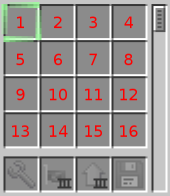Slot Alignment
Internal versus External Slot Alignment
Slot indexes do not match between the robot's internal and external view of its inventory
When a robot interacts with its own inventory it is using its internal view. You access the inventory of another robot via its external view.
The reason for this distinction is to separate the two inventory spaces: the main inventory and the tool belt inventory. Internally, the robot selects slots only in its inventory space, and not its toolbelt. It can equip or unequip items from its toolbelt. However, externally, an observer interacts with a single inventory that includes both the toolbelt as well as the main inventory.
Internal Robot Slot Alignment
The Robot's GUI displays the slots of a robot aligned from top-left to bottom-right. So for example the slot at index 1 is displayed in the top-left corner, the slot at index 2 is the next to the right and the first slot on the 2nd row is index 5.
These are the slot indexes a robot uses on it self (for its own main inventory, an interview view).
How many slots a robot has available depends on it's setup. If a slot is specified in a function that exceeds the amount of slots a robot has available an error is thrown.
The robot can select, place, drop, compare (etc) items from its main inventory using these slot indexes as they represent the internal perspective of its inventory.
External View of a Robot Inventory
Slot indexes of a robot's inventory to an outside observer will be offset by 4. To an outside observer, slots 1 through 4 refer to slots in the robot toolbelt. The first slot of the main inventory is slot 1 from inside the robot (internal view), but is thus slot 5 to an outside observer. Yes, this can be confusing at first. This design choice was made so that, to an outside observer, [slot 1] always indicated the first toolbelt slot regardless of the robot inventory size, and [slot 5] was always the first main inventory slot.
The robot inventory, again to an external observer, is sided inventory. The robot will not share all its inventory to all sides. Slot indexes do not change to these different sides. Slot 1, therefore, always refers to the first toolbelt slot, even when inaccessible to a side.
- From its left side it share nothing.
- From its right side it shares only its toolbelt slots (1-5)
- From all other sides it shares only its main inventory slots (5-n)
